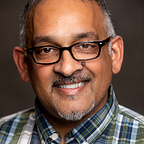10 Questions To Begin Decolonizing Mathematics In Your Classroom
This is a follow up to my previous article.
_________________________________________________________________
In order to rehumanize mathematics, which has been an emergent theme recently in mathematics, we must first start to tell the correct, historical story of mathematics. It is rich and complex, having much of its roots hidden, ignored, and marginalized. For many students — and teachers — the accepted history, which is backed up by the way that mathematics looks in most K to 12 curricula, looks like the image below.
Thankfully, to the academic diligence of Joseph, and his groundbreaking book, Crest of the Peacock: Non-European Roots of Mathematics, we now know that the trajectory of mathematics reaching and being developed in Europe came through a rich reservoir of cultures and civilizations.
We need to stop teaching mathematics through an outdated lens. We need to begin to teach it through the more vibrant prism of its true and colorful history.
Here are 10 questions that can be woven into your lessons to begin the journey of excavating mathematical ideas that have been historically buried/devalued.
- Which number is bigger: -7 or -4?
Answer: -7. While some context is required, the magnitude of negative 7 is bigger than the magnitude of negative 4. Zero is the smallest number. The West did not get the full, correct understanding of zero from India that Brahmagupta had assigned properties for.
2. What other bases besides 10 have humans used for counting?
Answer: Bases 20 and 60 (Africa, Mayan and Babylonian cultures)
3. What is the oldest known math artefact?
Answer: The Lebombo bone, which has 29 notches, has been dated back to 35000 BCE
4. What is the origin of the game Mancala?
Answer: It dates back to around 700 CE(modern Ethiopia and Eritrea). It’s counting roots are agricultural with seeds/sowing. There are over 100 variants, including Oware, which is a more adult version of the game.
5. Which civilization gave rise to fractions?
Answer: Egypt. Around 1800 BCE.
6. What kind of fractions did they use and why did they use them?
Answer: Unit Fractions. For comparison simplicity, equitable division of market goods, and perhaps mathematical elegance.(direct students to Rhind Mathematical Papyrus)
7. What is the origin of the numbers 2, 3, 5, 8, 13, 21, 34, 55, etc.?
Answer: Sanskrit poetry. Examining how different kinds of poems can be made with long(guru) and short(laghu) vowels, the “Fibonacci”numbers appear. The work can be traced back to Pingala around 200/300 CE.
8. Why is a second-degree polynomial referred to as “quadratic”(meaning “four”?)
Answer: The word is derived from the Latin word, “Quadrum”, which means square. This approach was used by the Babylonians in mathematical problems — to complete a square.
9. Pascal’s Triangle is called different names in different countries, as its basic ideas were explored by mathematicians prior to Blaise Pascal. What is it referred to in China?
Answer: Yang Hui Triangle
10. What is the origin of the complex symmetries used in Islamic temples and in the famous palace/fortress, Alhambra in Grenada?
Answer: Since Islamic religion prohibits depicting the human form, much focus was placed on illuminating beauty through complex geometries.
When we talk about history, we end up in the warm well of storytelling — the most powerful way to teach and connect. This automatically begins the tethered ideas of rehumanizing and decolonizing mathematics. They are inseparable. So much ancient wisdom lies in the history of any subject, but for mathematics it is a colorful exposition of its unflinching humanity.
There are many, many more questions about the roots and origins of mathematics to bring into our classrooms. Many will be prompted by simply going down the rabbit holes of the questions above.
We, as humans, are natural lovers of stories. As math educators, while a more robust math history might have been obscured by the traditional whiteness that most of us encountered, it is never too late to begin the journey to the “crest of the peacock”.
